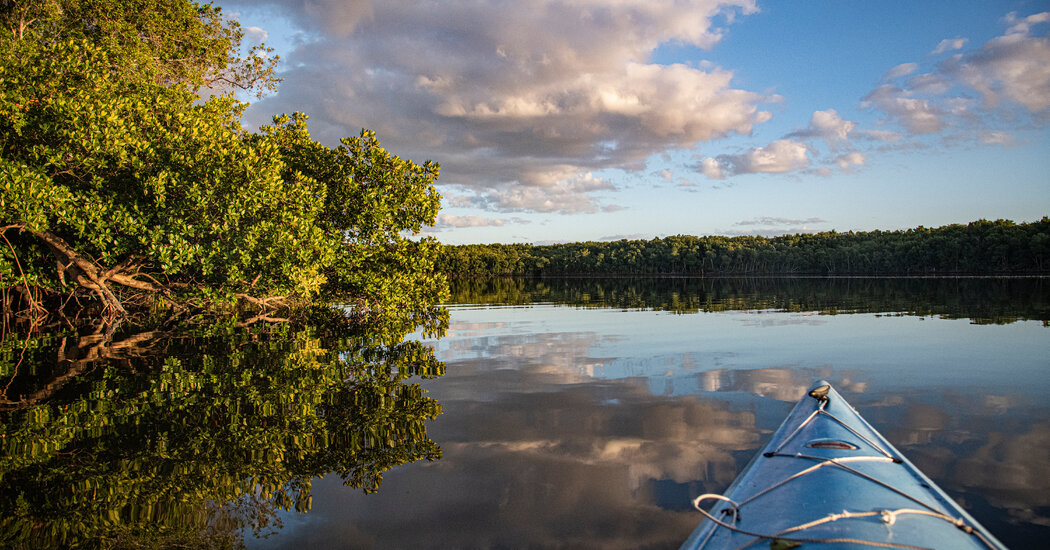
From a distance, the mouth of the creek was indistinguishable from the thick tangle of mangroves that concealed it — as if the narrow waterway were only willing to reveal itself to those who knew to look.
We approached attentively, unhurriedly, scanning the banks for alligators and wading birds. Twenty feet in front of us, a white ibis, hunting in the shallows with its long curved bill, squawked and took flight, fluttering out of sight.
A few minutes later, we found ourselves under a canopy of overarching branches. With the tide ever so slightly in our favor, I lifted my paddle and felt my kayak being pulled gently along, the mangroves and their many inhabitants — most of them hidden — scrolling past my periphery.
I closed my eyes to focus on the soundscape. The distant splash of a fish leaping from the water. The slow crescendo of a gust of wind passing through the trees. Silence.
Hidden away in Gopher Key Creek, deep in the arterial waters of Everglades National Park, I was experiencing as close to a moment of pure serenity as I’ve found anywhere in the world.
Truth is, this wasn’t quite the pace I’d planned for. A day and a half earlier, I’d set off with my sister and a friend to tackle the Everglades Wilderness Waterway, a 99-mile paddle route that winds its way — through large bays, wide rivers and narrow creeks — from Everglades City, in the north, to Flamingo, in the south. We’d made arrangements to complete the route in eight days, averaging around 15 miles per day, accounting for some add-ons. What we couldn’t fully account for was Florida’s volatile weather.
A mile or so from the start, after pressing forward with our itinerary despite high winds and an incoming storm front (and with an assurance from our outfitter, Bobby Miller Jr., that he’d swoop in and fetch us with his boat should the weather really go south), one of our kayaks started taking on water. Then came worse news: A tornado was headed our way. We huddled against the coast, sheltering from the storm in a cluster of mangrove roots, and waited for Captain Bobby to scoop us up, narrowly missing the vortex as it cut through Everglade City.
Later that night, back on land, we reassessed our plans. Having lost a day on the water, and with stormy weather lingering into a second, we reluctantly conceded that completing the full waterway was no longer a reasonable goal; making up for lost time by rushing headlong through long stretches of the route was an unpleasant and unrewarding prospect. Instead, we reworked our itinerary and planned for a less ambitious loop, with fewer miles and more time for close observation.
Florida’s Everglades, a singular ecosystem that encompasses the largest subtropical wilderness reserve on the North American continent, is best known for its vast stretches of freshwater marsh, or sawgrass prairie, which gave rise to its abiding description as a “river of grass.”
Go Wild This Winter
The outdoors is still amazing, even in the cold. Time to rug up and explore.
- Spot Wintry Wildlife: From great gray owls in Minnesota to bison in Florida, you have many opportunities to see animals in the wild.
- Uplifting Encounters: Even if you are not an expert bird-watcher, hanging out with some Canada jays could do wonders for your mood.
- Winter Camping: For well-prepared adventurers, sleeping outdoors in the cold elements has many benefits — and fewer crowds.
- Dog Sledding in Maine: Traversing a frozen lake can be a dreamy experience. Just remember the brake — and no Instagram selfies.
The iconic marsh, however, is only one of the Everglades’ several distinct habitats, which also include pine rocklands, tropical hardwood hammocks, mangrove forests and marine and estuarine areas. It was in the last of these two habitats that we spent our days, paddling through scenery that the biologist Daniel Beard, who would become the park’s first superintendent, described in a 1938 report as a “study in halftones,” filled not with the sublime features found in most of America’s other national parks, but with “lonely distances, intricate and monotonous waterways, birds, sky, and water.”
The campsites in the Everglades wilderness are unlike any I’ve encountered. In the interior of the waterway, away from the coast, small clearings in the mangrove forests form ground sites, some of which sit a few feet above the water line on shell mounds built countless generations ago by the Calusa, a Native people who dominated southwest Florida for many hundreds of years.
The beach campsites that line the Gulf side of the waterway offer an airy respite from the dense confines of the interior.
But the most visually distinctive of the campsites, built in places otherwise ill-suited for tents, are the chickees, a term derived from the word for “house” in Mikasuki, a language spoken by many members of the Miccosukee and Seminole tribes. The simple structures, each only 10 feet by 12 feet, are little more than elevated stilt platforms — and, lacking walls, they’re unforgiving of errant footsteps.
The tranquillity we experienced atop the Sweetwater Chickee, tucked away from the Wilderness Waterway by a mile-long tendril of water, was broken in the early afternoon by the sudden screeching of an osprey, grasping a fish in its talons, as it tried to evade a pair of bald eagles. In the middle of the night, the heavy exhales of an animal breathing at the surface of the water — it sounded distinct from that of the dolphins we saw surfacing in the moonlight the night before — left us wondering how close the tide would lift the water line to the edge of our tiny, exposed shelter.
Though it now covers more than 1.5 million acres, Everglades National Park, established in 1947, protects only around 20 percent of the original Everglades ecosystem, whose waters once trickled — without man-made obstruction — from the Kissimmee River and Lake Okeechobee south to the Gulf of Mexico and the Florida Bay.
Even the early Calusa people, whose fishing and foraging communities were concentrated along the coast, found reason to engineer the landscape by building mounds from hundreds of millions of oyster shells, among other discarded objects, creating islands where none existed before.
But it wasn’t until the late 1800s that the historical flow of fresh water from Lake Okeechobee began to be impeded, and the ecosystem itself disrupted, first by settlers and land developers hoping to drain the marshland, and later by the Army Corps of Engineers, which built an immense network of canals, levees and pumping stations designed to help facilitate and protect South Florida’s extensive urban and agricultural expansion.
The detrimental effects of those drainage, water-diversion and flood-control schemes — habitat loss, endangered plants and animals, an ecosystem starved of fresh water — have been exacerbated in more recent years by pollution, the introduction of invasive species (like Burmese pythons and Brazilian peppertrees), explosive population growth, intensifying storms and rising sea levels.
Meanwhile, ambitious legislation aimed at reviving the ecosystem — by restoring the historical flow of fresh water — has progressed only in fits and starts.
Despite existential challenges, the Everglades remains an extraordinary haven for wildlife. In our six days on the water, we saw hundreds of wading birds — herons, egrets, ibises, anhingas and spoonbills. Bald eagles, red-shouldered hawks and ospreys also made frequent appearances, along with American alligators, dolphins, bull sharks and a wealth of colorful flora: towering gumbo limbo trees, vibrant beach beans and rare orchids — not to mention an endless stream of mangroves.
Often the wildlife would materialize only after startling us with unexpected sounds: the raucous chattering of the dawn chorus, the violent splash of a dolphin’s tail on the glassy water, the heavy whoosh of a great blue heron as it lifted from its perch near a creek, the hooting of a barred owl — Who cooks for you! — as dusk settled around our camp.
In the late 19th and early 20th centuries, plume hunters, supplying unquenchable millinery markets in New York and London, ravaged the area’s bird populations, nearly wiping some species out altogether. And birds weren’t the only casualty: Alligators were targeted for their hides, and old-growth cypress groves for timber.
Having read about the brutal methods used to slaughter the water birds and alligators, I couldn’t help but wonder how different our experience would have been — how crowded the skies, how numerous the rookeries — had we been able to glimpse the same land- and waterscapes before our collective greed, and a lack of regulation, had altered them forever.
No doubt the trip had its moments of difficulty. Hauling our water in thick raccoon-proof containers — about 18 gallons of it, weighing some 150 pounds — was a heavy burden. (No fresh water is available along the waterway, and the park recommends bringing one gallon per person per day.) Temperatures in mid-January fluctuated dramatically: down to the 40s at night, and into the 80s in the piercing midday sun. The moon, which reached its full phase during our first night on the water, was stunningly bright, hanging over our tents like an unforgiving flood light.
And then there were the bugs, namely no-see-ums and mosquitoes. At our campsite on Mormon Key, the mosquitoes swirled so thickly, so fervently, that the sound of their buzzing was enough to keep me awake at night, despite my feeling exhausted after our longest and most active day on the water. (The bugs themselves were separated from me, thankfully, by the mesh of my tent — or most of them were, anyway.)
Still, the discomforts were a minuscule price to pay for the transformational experience of being in the Everglades with an abundance of time to look closely, to listen intently and to absorb the scenery around me, which in the end was worth any number of bites, scrapes and blistered fingers.
After four days spent exploring bays, rivers and creeks, we paddled to the mouth of the Chatham River and entered the Gulf of Mexico, where we’d camp for the next two nights on the beaches of spindly keys, just a few feet above the high tide line.
Out in the Gulf, the trip took a more familiar turn. Having left the enclosed waterways and confined campsites, which left us with little room to roam on foot, we were finally free to unfurl our legs and wander along the shell-scattered sands, mesmerized by the murmurations of seabirds and the endless horizon beyond.
Even here, though, among the darting sandpipers and terns, the mangrove forests still dominated the interiors of the islands, forming what felt like an impenetrable wall on the backside of the beaches.
On Pavilion Key, the last of our campsites, I had time to ruminate on their ubiquity, and on their central role in the Everglades ecosystem — as buffers against erosion and floodwaters, and as key nursery habitats to crustaceans, fish, birds and reptiles.
My thoughts kept returning to that first day on the water. As the tornado loomed menacingly in the distance, our instinct was to paddle toward the mangrove-lined shore. It was close to low tide, and we were able to stand in the shallows, our feet squishing disconcertingly deep into the muddy banks.
There, clinging to the mangroves’ arching roots as the winds swirled ever more intensely, I experienced a kind of momentary kinship, I realize now, with the many other life-forms we would encounter in the days to come: the oysters, the crabs, the snails, the insects, the wading birds, the air plants, the moss and lichen — all of them clinging at times to the mangroves, all of them fragile and exposed, all of them interconnected, all of them susceptible to a set of changing conditions that threatens to alter or destroy their habitats.
The steady geographic shift of mangroves in South Florida — north as a response to rising ocean and air temperatures, and inland as a response to rising sea levels — is called a “migration.” It’s a telling anthropomorphism, and it’s only a prelude of what’s to come.
Because of the rate of sea-level rise, coastal mangrove forests will face uninhabitable conditions in as little as 30 years. In the Everglades ecosystem, the trees’ migration inland, which is already leading to the displacement of other native plant communities, will eventually be halted by the many man-made impediments that litter the landscape. As a result, according to some scientists, much of Florida’s mangrove forests may be replaced by open water by the end of the century.
And so, as with many of our ecological crises, time is running out. Will we act — regionally and globally — in time to protect the mangroves, which, living at the juncture between the land and the ocean, are among the first organisms to bear the burden of rising seas? Will we act in time to protect the flora and fauna that make their homes among their roots and branches? Will we swoop in to rescue them from the intensifying storms? Or will we allow the swelling oceans to rise unabated and drown them along the way?
To those questions, the watery world of the Everglades can provide no answers. That’s for us to decide. Instead, the South Florida ecosystem quietly offers up a vivid reminder of exactly what’s at stake — first for the migrating mangroves, and then, at last, for us.
Stephen Hiltner is an editor and photojournalist on The New York Times’s Travel desk, where he edits and contributes to the weekly World Through a Lens column. You can follow his work on Instagram and Twitter.
Have a question about the Everglades or the Wilderness Waterway? Ask him in the comments section.
Audio production by Tracy Mumford. Audio design by Matt Ruby. Audio engineering by Dan Powell.




